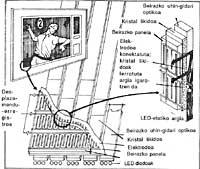TV screen at laun
This new method of creating images incorporates a network of thin and parallel glass strips. These bands drive on a panel the red, green and blue light produced by the video signal. At the right time, some electrodes switch liquid crystals in contact with bands ( liquid crystal ; LC) and cross the lights to form TV or computer images.
The Imperial College of Science and Technology in London, among other things, is developing a flat screen in recent times. This display is a large surface liquid crystal "display" that does not resemble any other. Unlike the liquid crystal screen of laptops, this is colourful, with a bright and contrasting image and a wide viewing angle. This display combines optical wave guides and electronic switching in the same concept.

Although this concept has begun to develop in this centre of London, it is an important improvement for screens such as television or computer. A British data communications company is pushing the project for this product to enter the market as soon as possible.
This screen is based on the fact that the beam of light sent from the inside of a thin band of glass is released by a system of windows at any point of the length of the band as a point of light.
This controlled release of light is achieved by intercaling liquid crystal material between the columns formed by a glass sheet and a thin glass band. In liquid crystal displays, the molecules block or let the light pass under the influence of the voltage forming an image. In this experimental panel are crushed materials against bands. Thanks to their low refractive figures, the molecules of these materials are normally oriented so that the light is not affected by the conduction of the glass bands.
But the increase in the refractive index in a specific point of the band makes it a transparent band in that place, instead of hindering the passage of light. To modify the index, voltage pulses are applied to the electrode lines of the glass panel. The electric field of these pulses modifies the orientation of liquid crystal molecules and the refractive index. The liquid crystal material is in contact with the optical bands, so the light can come out becoming a small element of image.
The panel design should be adjusted to each application. For example, on the TV screen, the number of horizontal lines of electrodes would be equal to the number of lines of the television standard. (625 in Europe; 525 in the US).
In the case of television, the width of each vertical glass strip would also be 2 mm, forming a panel of 1'2 meters of width appropriate to place hundreds of them on the wall. Each band would have at its lower end three LED diodes (L.E.D; light emithing diode), one red, another green and another blue. A distributor that separates the red, green, and blue component from the video signal would activate the diodes of each glass column. And the circuits that switch the volts of the electrodes, precisely synchronized with the video signal, would allow the light to be repelled forming television images.
This is the theory. And the principle works in the prototype. But there is still much to do. On the one hand, obtain the best time constant of switching of the liquid crystal and, on the other, shorten the recovery times in order to discard the undesired light duration after switching. These are the critical factors. If these problems were overcome, the rest would be simple and the big screen of television and in just four years would be ready.
Buletina
Bidali zure helbide elektronikoa eta jaso asteroko buletina zure sarrera-ontzian











